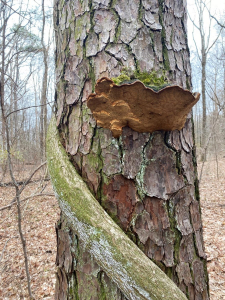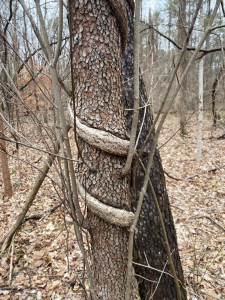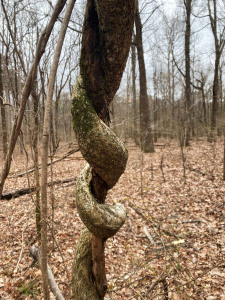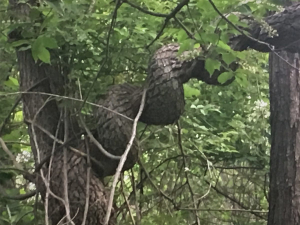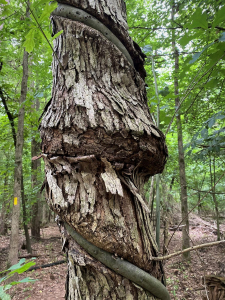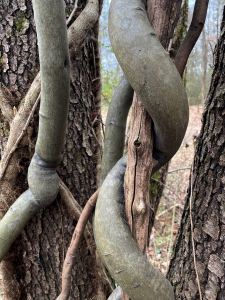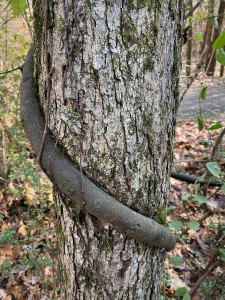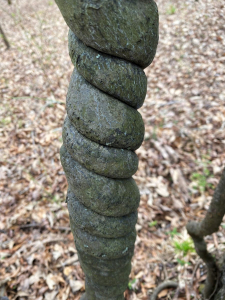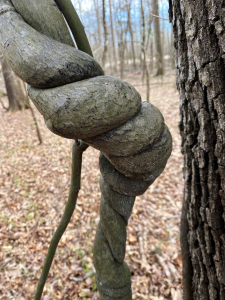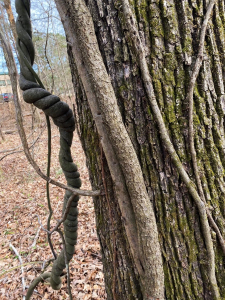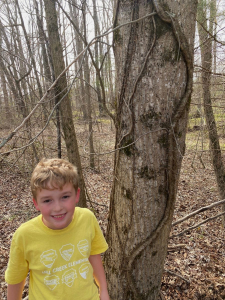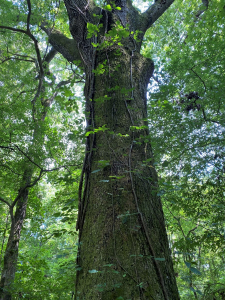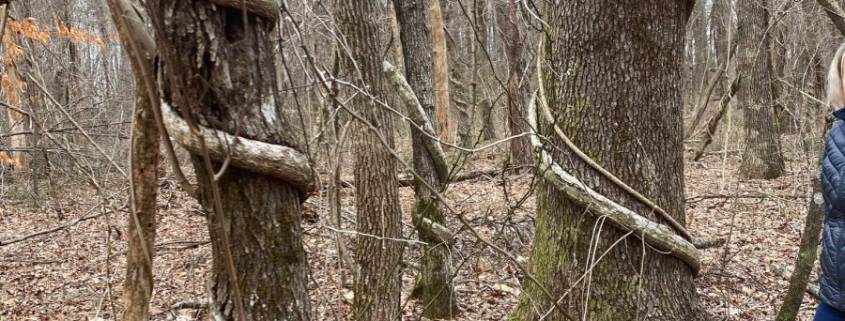March 19, 2022 I hiked the Fire Tower and South Plateau Trails at Monte Sano State Park near Huntsville, Alabama. I issued a Post about the general wonders of Nature we encountered along the way: https://stevejonesgbh.com/2022/05/12/march-19-2022-on-the-fire-tower-trail-at-monte-sano-state-park/
That Post included several photos and observations about some tree form curiosities. Here are two without comment:
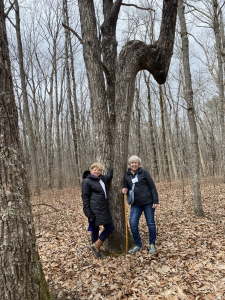
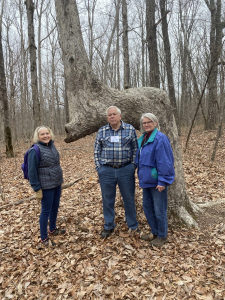
I’m fascinated with tree form oddities. I have also chronicled the nature of grape vines in our north Alabama hardwood forests in my Great Blue Heron Posts. This photo shows a large grape vine (genus Vitis) along the Multi-use Trail at Joe Wheeler State Park from the summer of 2020. Most casual hikers consider such vines, common in our maturing second-growth forests, as climbing vines.
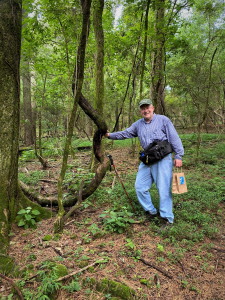
People have the mistaken impression that muscadine, scuppernong, poison ivy, Virginia creeper, wisteria, and supplejack vines actually ascend the tree trunk to access the upper canopy. That is, these vines climb into the trees. Such is not the case. Our common forest vines are the same age as the trees in the forest. The vine seedlings germinated or vegetatively sprouted with the new forest. Picture a yellow poplar or oak sapling growing rapidly in an area where the prior forest has been blown flat by a wind storm. A grape vine, like the oak or poplar, is responding to the now-available full sunlight and fresh nutrients. The vines cannot stand on their own. They depend on trees to achieve verticality. They keep pace with the tree, securing their elongating shoots interlaced with the oak and poplar crowns. In this fashion, over the course of the 80-90-year span of the forest we hiked March 19, the vines achieve and maintain access to sunlight in the maturing main canopy. Their roots stay firmly planted in the forest soil 70-80 feet below.
I address the viny forest component because the tree-climbing pattern of Japanese wisteria caught my eye as we hiked recently at Monte Sano, leading me to muse with you on the spiral nature of some species of our north Alabama tree climbing vines. While in the forest I knew these were wisteria. Only upon further investigation did I confirm their identity as Japanese wisteria, an invasive. As we hiked, I heard various speculations as to why all that we encountered spiraled upward clockwise. Some offered the Coriolis effect, suggesting that vines spiral counterclockwise south of the equator. Others mentioned latitude as a controlling variable. I did not speculate.
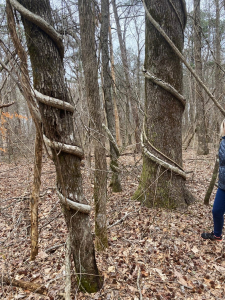
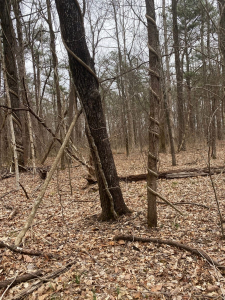
Upon returning home, I learned that a diagnostic character of Japanese wisteria (Wisteria floribunda) is its counterclockwise spiraling. American wisteria spirals clockwise.
Alan S. Weakley, North Carolina based expert on southern flora, wrote this about the direction of spiral: Twining direction can be determined by looking at (or imagining) the vine twining around a branch or pole. Look at the pole or branch from the base (from the direction from which the vine is growing). If the vine is circling the branch or pole in a clockwise direction, that is dextrorse; if counterclockwise, that is sinistrorse.
So, the direction of spiral is not owing to an environmental factor; it’s genetically determined. Now the question is why the direction is hard-wired. Is there some evolutionary advantage in one way or the other deep in the genetic footprint? If so, why do Wisteria americana and frutescens twine in the opposite direction from their Asian cousin? I suppose that deeper mystery will remain for another day.
I concluded long ago that woods wanderings will continue to generate more questions than I will ever answer — more mysteries than I will ever solve. My quest to learn more will exceed this lifetime. That is part of my pleasure in venturing into the forest and writing these Posts.
The important thing is not to stop questioning. Curiosity has its own reason for existing. One cannot help but be in awe when he contemplates the mysteries of eternity, of life, of the marvelous structure of reality. It is enough if one tries merely to comprehend a little of this mystery every day. Einstein
I have no special talent. I am only passionately curious. Einstein
Spiraling Forest Vines
I’ll continue our vine photo-journey without a lot of narrative. The wisteria below left chose a tree species that fell short of giving the vine access to full sunlight in the upper canopy. Its dogwood elevator delivered it only to lower levels. Dogwood is shade tolerant and can function quite well in dappled sunlight over the life of the stand. It has no need to rise into the main canopy. The wisteria below right is the only specimen we found growing on a pine (loblolly). That’s a bracket mushroom on the pine, signaling decay within. The wisteria does not concern itself with the decay that lies hidden within the trunk, even though the decay, if it proves fatal to the pine, will topple the pine and the vine to the forest floor. The vine will have produced many seed crops by then. It will have done its work toward succeeding itself.
Also on the Monte Sano hike, I photographed this wisteria vine twining with a grape vine dangling from above.
Spiraling Vines from Previous Woodland Hikes
Noticing woody vines reaching into the main forest canopy is not new to me. I’ve been snapping photos since the onset of these Posts. This is grandson Sam posing a couple of years ago (2/23/20) on the Wheeler National Wildlife Refuge, hanging onto a supplejack vine, which in turn is spiraling counterclockwise on a sweetgum sapling.
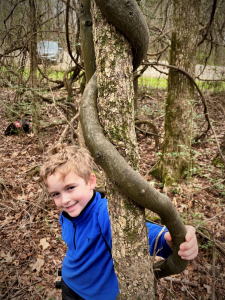
Also on the Refuge, I captured the image (below left) February 6, 2022. This one requires a bit of forest forensics. The sapling, I believe sweetgum, engaged previously in fierce struggle with a counterclockwise-spiraling supplejack. The sweetgum prevailed, still displaying the permanent scar of its choking engagement with the now deceased and decomposed vine. Below right on the same day I found a spiral-scarred stem, evidencing a struggle with neither stem or vine surviving. Our woods are filled with tales of wins, draws, and losses. Forests may appear to be places of peace, tranquility, as well as community cooperation and synergism. Contrary to those appearances, it’s a dog-eat-dog sylvan world. Only the forest itself survives. It’s every tree, vine, insect, fungus, and critter for itself.
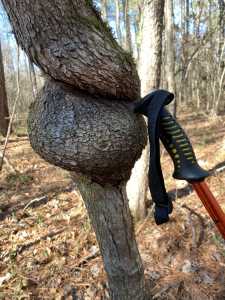
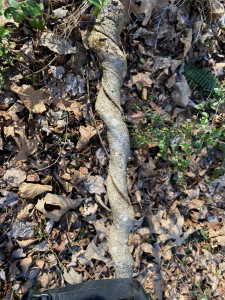
May 12, 2019, along the Chesapeake and Ohio Canal National Historical Park in Maryland, ever on the lookout for curiosities, I photographed this massive oak branch, likely vine-spiraled over decades, once again counterclockwise.
I discovered this oddy-spiralled white oak June 8, 2020 along the Awesome Trail in Joe Wheeler State Park. The oak is currently engaged with a living supplejack vine. The grasp is tight enough that the oak is growing around the two visible vine segments and has encased the middle spiral. I can’t imagine how the vine will survive the ever tightening strangle of the oak wood closing around the vine.
December 4, 2021, I found this supplejack tangle at Joe Wheeler State Park. Even within this scrum of vines, the central individual demonstrates the species’ distinctive counterclockwise spiral. The supplejack has fidelity to its genetic roadmap, a vine maelstrom be darned!
Here’s a December 15, 2019 supplejack clinging to a sugar maple on the Wheeler National Wildlife Refuge.
Supplejack does not discriminate when it comes to selecting a stanchion to ascend. Along Bradford Creek as it passes Liberty School March 21, 2022, grandson Sam and I discovered a double supplejack spiral (below left). Another, not quite as tightly wound, is on the right.
A wider view of the left image shows that double twine dangling beside a sweetgum with two non-spiraling poison ivy vines.
Therefore, we have another question to ponder beyond why some vines spiral clockwise and some not. That is, why do some species catch a ride to the main canopy without spiraling at all? I admit to not having the answer. I’ll simply offer a few photographic examples of non-spiraling forest vines.
Non-Spiraling Forest Vines
I don’t recall seeing any grape (Vitis sp.) or poison ivy vines spiraling. I conclude that neither has the genetic wiring that includes spiraling as a climbing alternative. While Sam and I explored the riparian forest at Liberty we found this yellow poplar with multiple poison ivy vines. Poison ivy’s mat of air roots cling tenaciously to the trunk. Remember, the lower vine’s sole purpose is to maintain its position while the forward elongating crown keeps pace above in the poplar’s crown. It’s all about access, courtesy of the poplar, to full sunlight.
And we’re talking about reaching full sunlight more than ten stories above in this riparian forest within the Wheeler National Wildlife Refuge, high in this red oak. These Vitis vines don’t bother with producing leaves trunk-side. The light below the canopy doesn’t meet the vine’s minimum requirement for leaf investment. It needs the light available in the shared crown.
Early July 2020, Alabama State Parks Naturalist Emeritus Mike Ezell and I stopped to admire these old Vitis vines along the Awesome Trail. They still extend into the main canopy. We puzzled why their bases are now contorted and slumped to the ground. Several are five or more inches in diameter. Some, like one where Mike is posing as The Thinker, stretch and loop for tens of feet, eventually reaching toward the crown heavens. Why do they twist and loop near the ground? I will continue to seek answers in the evidence within other forests.
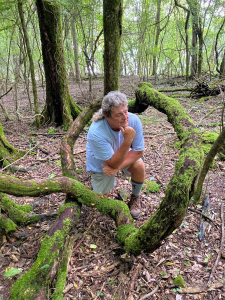
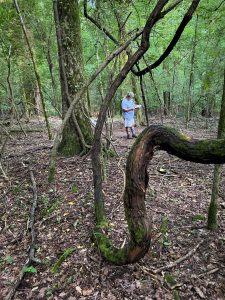
I recall regenerating southern pines on Union Camp company lands through the 70’s. We planted genetically improved nursery stock on land we had clearcut and site prepared. Occasionally we would fall short of subduing Vitis prior to planting. If too vigorous, the vines would smother the newly planted stand. The pine below in a mixed loblolly pine and hardwood stand carried vine companions into its crown. The phenomenon is not unique to hardwood forests. Note how the vines have long ago detached from the pine’s main stem, and now hang loosely from the trunk. Perhaps I have from photo to photo discerned at least a partial answer to my query about the loops of mature vines several paragraphs prior.
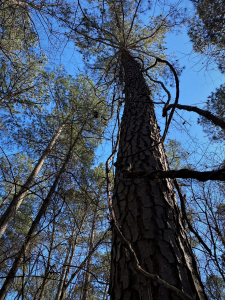
I’ll close this Post with a poison ivy vine growing snugly to a 15-inch diameter red oak. It’s nestled in the tree’s moss skirt, appearing to be part of the tree. I’ve found such trees toppled by wind, the vine still alive, struggling to find sufficient light far below the canopy above. Limited sunlight from the windfall opening will continue to bless the fallen vine…until adjacent trees above fill the void. The toppled vine will survive only so long as the light persists. So, the vine and tree grow up (in time and space) together…and they die more or less as one.
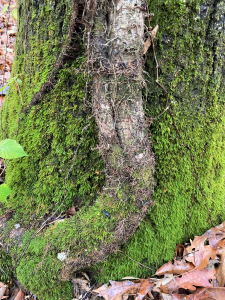
I offer a final element of puzzle. I can clearly ascertain an evolutionary advantage to vines that can grow into the main canopy, where they can capture sufficient light to thrive, live safely above the browsing reach of ground-dwelling herbivores (like deer), and can more assuredly disperse seeds by birds and squirrels. I suppose the viny species compromised over the sweep of evolution. They could no longer, as canopy occupants, insist upon full, rich, heavy-crowned tops. That is, they could not both occupy the main canopy and compete so aggressively with the tree that its physical host succumbed. How did the tree benefit from agreeing to share the heights? I can imagine that a viny crown serves as more favorable habitat for birds and squirrels. How is that an advantage to the oak. Birds are voracious insect-consumers. Insects that can consume leaves, oviposit into buds, and create infection ports for decay fung. And while squirrels eat acorns, during years of heavy acorn production, the aerial rodents (and blue jays) cache more seed than they can possibly find and consume. So, I view the vine/tree relationship as symbiotic generally.
I have not mentioned kudzu, an invasive vine that can, in fact, literally climb and suffocate existing forests. Forests and kudzu are not compatible. I’ll leave it at that.
Alabama State Parks Foundation
Thoughts and Reflections
I offer these observations:
- Lessons are written along every forest trail.
- Curiosity opens many doors to discovery in Nature; I implore you to be passionately curious.
- So much in Nature is hidden in plain sight.
Inhale and absorb Nature’s elixir. May Nature Inspire, Inform, and Reward you!
Note: All blog post images created & photographed by Stephen B. Jones unless otherwise noted. Please circulate images with photo credit: “©2022 Steve Jones, Great Blue Heron LLC. All Rights Reserved.”
Another Note: If you came to this post via a Facebook posting or by an another route, please sign up now (no cost… no obligation) to receive my Blog Post email alerts: http://eepurl.com/cKLJdL
And a Third: I am available for Nature-Inspired Speaking, Writing, and Consulting — contact me at steve.jones.0524@gmail.com
Reminder of my Personal and Professional Purpose, Passion, and Cause
If only more of us viewed our precious environment through the filters I employ. If only my mission and vision could be multiplied untold orders of magnitude:
Mission: Employ writing and speaking to educate, inspire, and enable readers and listeners to understand, appreciate, and enjoy Nature… and accept and practice Earth Stewardship.
Vision:
- People of all ages will pay greater attention to and engage more regularly with Nature… and will accept and practice informed and responsible Earth Stewardship.
- They will see their relationship to our natural world with new eyes… and will understand more clearly their Earth home.
Tagline/Motto: Steve (Great Blue Heron) encourages and seeks a better tomorrow through Nature-Inspired Living!
Steve’s Three Books
I wrote my books Nature Based Leadership (2016), Nature-Inspired Learning and Leading (2017), and Weaned Seals and Snowy Summits: Stories of Passion for Place and Everyday Nature (2019; co-authored with Dr. Jennifer Wilhoit) to encourage all citizens to recognize and appreciate that every lesson for living, learning, serving, and leading is either written indelibly in or is powerfully inspired by Nature.
I began writing books and Posts for several reasons:
- I love hiking and exploring in Nature
- I see images I want to (and do) capture with my trusty iPhone camera
- I enjoy explaining those images — an educator at heart
- I don’t play golf!
- I actually do love writing — it’s the hobby I never needed when my career consumed me
- Judy suggested my writing is in large measure my legacy to our two kids, our five grand kids, and all the unborn generations beyond
- And finally, perhaps my books and Blogs could reach beyond family and touch a few other lives… sow some seeds for the future

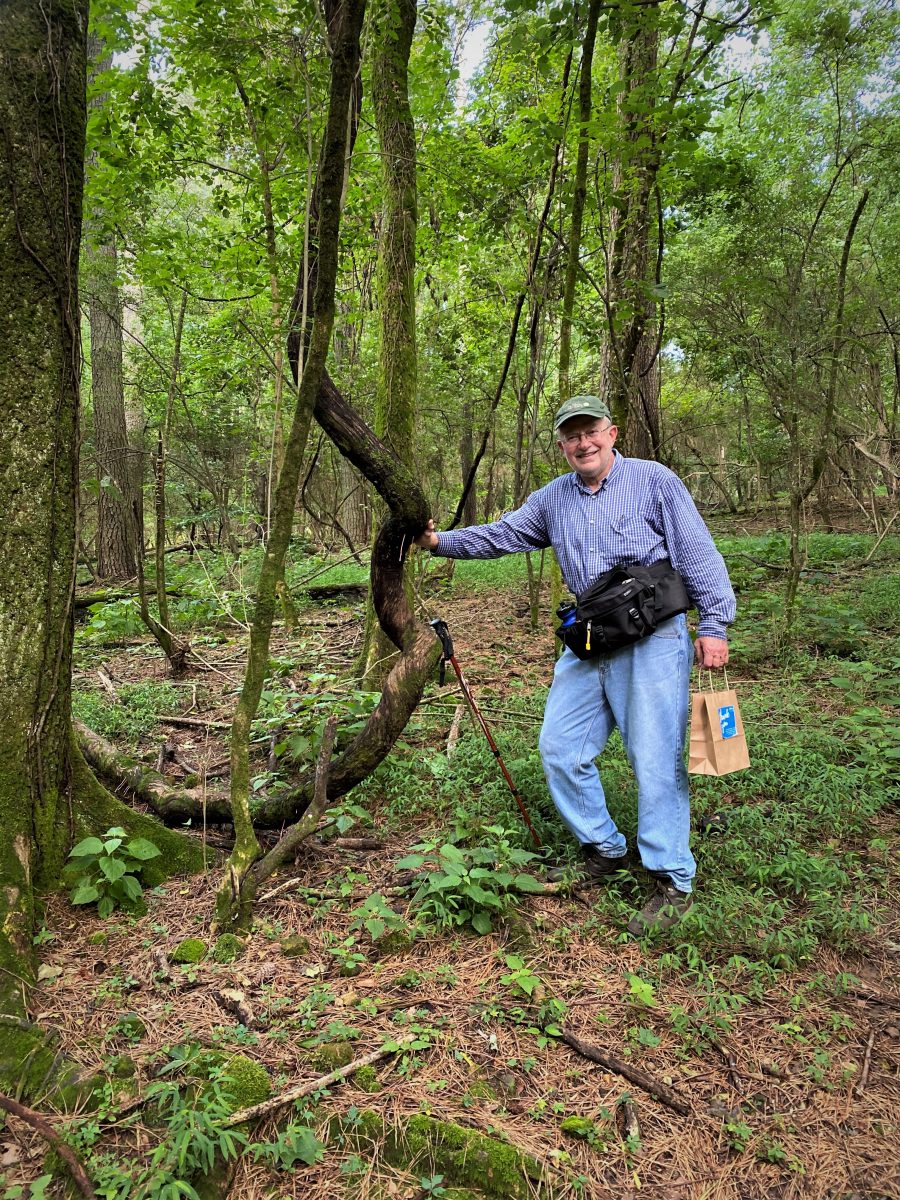
All three of my books (Nature Based Leadership; Nature-Inspired Learning and Leading; Weaned Seals and Snowy Summits) present compilations of personal experiences expressing my (and co-author Dr. Wilhoit for Weaned Seals and Snowy Summits) deep passion for Nature. All three books offer observations and reflections on my relationship to the natural world… and the broader implications for society. Order any and all from your local indie bookstore, or find them on IndieBound or other online sources such as Amazon and LifeRich.





